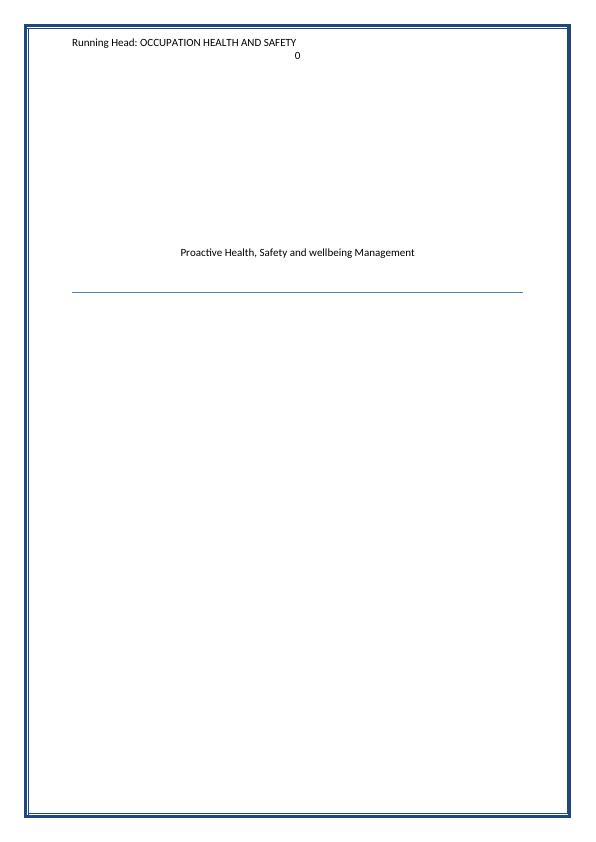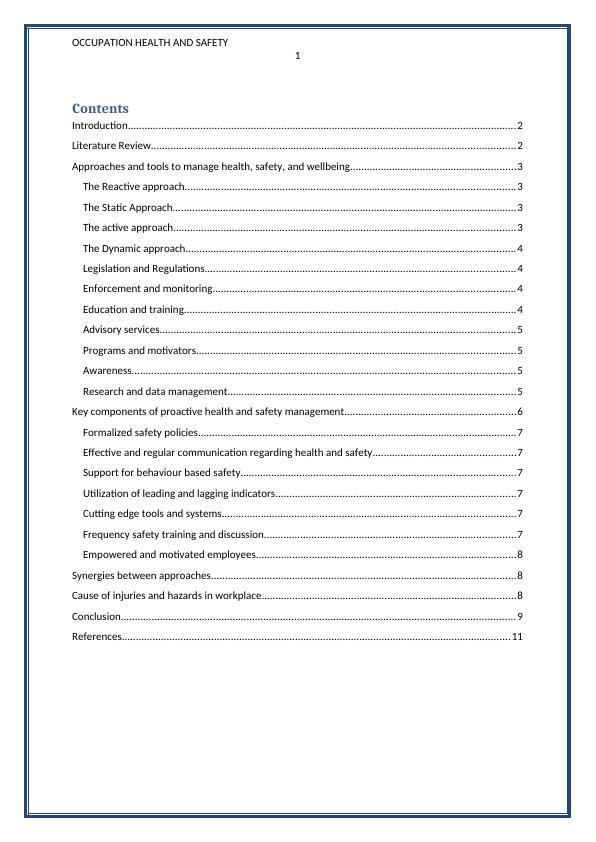Proactive Health, Safety and wellbeing Management
Explain and list the elements affecting the system which led to a stop work order. Elements /Gap Analysis /Literature review
14 Pages3992 Words498 Views
Added on 2023-06-09
About This Document
This article discusses different types of injuries, and hazards at the workplace, the role of safety, and wellbeing for workers in the construction industry and various approaches to reduce accidents, and injuries at the workplace. It also covers key components of proactive health and safety management.
Proactive Health, Safety and wellbeing Management
Explain and list the elements affecting the system which led to a stop work order. Elements /Gap Analysis /Literature review
Added on 2023-06-09
ShareRelated Documents
Running Head: OCCUPATION HEALTH AND SAFETY
0
Proactive Health, Safety and wellbeing Management
0
Proactive Health, Safety and wellbeing Management

OCCUPATION HEALTH AND SAFETY
1
Contents
Introduction...........................................................................................................................................2
Literature Review..................................................................................................................................2
Approaches and tools to manage health, safety, and wellbeing...........................................................3
The Reactive approach......................................................................................................................3
The Static Approach...........................................................................................................................3
The active approach..........................................................................................................................3
The Dynamic approach......................................................................................................................4
Legislation and Regulations...............................................................................................................4
Enforcement and monitoring............................................................................................................4
Education and training.......................................................................................................................4
Advisory services...............................................................................................................................5
Programs and motivators..................................................................................................................5
Awareness.........................................................................................................................................5
Research and data management.......................................................................................................5
Key components of proactive health and safety management.............................................................6
Formalized safety policies..................................................................................................................7
Effective and regular communication regarding health and safety...................................................7
Support for behaviour based safety..................................................................................................7
Utilization of leading and lagging indicators......................................................................................7
Cutting edge tools and systems.........................................................................................................7
Frequency safety training and discussion..........................................................................................7
Empowered and motivated employees.............................................................................................8
Synergies between approaches.............................................................................................................8
Cause of injuries and hazards in workplace...........................................................................................8
Conclusion.............................................................................................................................................9
References...........................................................................................................................................11
1
Contents
Introduction...........................................................................................................................................2
Literature Review..................................................................................................................................2
Approaches and tools to manage health, safety, and wellbeing...........................................................3
The Reactive approach......................................................................................................................3
The Static Approach...........................................................................................................................3
The active approach..........................................................................................................................3
The Dynamic approach......................................................................................................................4
Legislation and Regulations...............................................................................................................4
Enforcement and monitoring............................................................................................................4
Education and training.......................................................................................................................4
Advisory services...............................................................................................................................5
Programs and motivators..................................................................................................................5
Awareness.........................................................................................................................................5
Research and data management.......................................................................................................5
Key components of proactive health and safety management.............................................................6
Formalized safety policies..................................................................................................................7
Effective and regular communication regarding health and safety...................................................7
Support for behaviour based safety..................................................................................................7
Utilization of leading and lagging indicators......................................................................................7
Cutting edge tools and systems.........................................................................................................7
Frequency safety training and discussion..........................................................................................7
Empowered and motivated employees.............................................................................................8
Synergies between approaches.............................................................................................................8
Cause of injuries and hazards in workplace...........................................................................................8
Conclusion.............................................................................................................................................9
References...........................................................................................................................................11

OCCUPATION HEALTH AND SAFETY
2
Introduction
Health, safety, and well-being play an important role in workplaces in the last few years.
Many researchers indicate that health, safety, and well-being can affect workers,
employees, and organization in a negative manner. There are many factors that impact
on health and wellbeing of workers in construction industries, and workplaces such as
accidents, health hazards, injuries, safety hazards, and perils. Hazards and injuries in
workers at the workplace are very common and the main reasons for these accidents
and injuries are that lack of policies, lack of safety, and contact with high power
supplies. The main objective of this article is that identify different types of injuries, and
hazards at the workplace, the role of safety, and wellbeing for workers in the
construction industry and various approaches to reduce accidents, and injuries at the
workplace. According to World health organization, in last few years injuries and
accidents at the workplace are increased rapidly and the main reason of this increment
is that lack of policies and strategies at workplaces (Glendon, Clarke, and McKenna,
2016). This report is explaining about different types of approaches and methods to
reduce hazards, and accidents in the workplace, and manage health, safety, and well-
being of workers in the construction industry. In Singapore, to reduce hazards, and
accidents in the workplace, many organizations, and communities consider new
approaches to improve health, the safety of workers in the construction industry. Total
WSH is a new approach which provides a platform to improve the health of workers,
and also promote health in construction industries, and workplaces (Grant,
Christianson, and Price, 2007).
Literature Review
Safety at a workplace is very important in last few years, there are many accidents,
hazards, and injuries occur in construction industries, and workplaces due to lack of
policies, safety, and lack of health promotion (Guest, 2017). According to a report by the
World health organization, in construction industries and workplaces many workers
suffer from injuries, accidents, and hazards. Every 15 sec. a worker die due to an
accident or injury, and there are many reasons of this problem such as lack of policies,
and strategies, lack of equipment's, lack of safety place, contact with high power supply,
and lack of health, and safety organization (Hall, et al., 2016). Every day, around 6,300
2
Introduction
Health, safety, and well-being play an important role in workplaces in the last few years.
Many researchers indicate that health, safety, and well-being can affect workers,
employees, and organization in a negative manner. There are many factors that impact
on health and wellbeing of workers in construction industries, and workplaces such as
accidents, health hazards, injuries, safety hazards, and perils. Hazards and injuries in
workers at the workplace are very common and the main reasons for these accidents
and injuries are that lack of policies, lack of safety, and contact with high power
supplies. The main objective of this article is that identify different types of injuries, and
hazards at the workplace, the role of safety, and wellbeing for workers in the
construction industry and various approaches to reduce accidents, and injuries at the
workplace. According to World health organization, in last few years injuries and
accidents at the workplace are increased rapidly and the main reason of this increment
is that lack of policies and strategies at workplaces (Glendon, Clarke, and McKenna,
2016). This report is explaining about different types of approaches and methods to
reduce hazards, and accidents in the workplace, and manage health, safety, and well-
being of workers in the construction industry. In Singapore, to reduce hazards, and
accidents in the workplace, many organizations, and communities consider new
approaches to improve health, the safety of workers in the construction industry. Total
WSH is a new approach which provides a platform to improve the health of workers,
and also promote health in construction industries, and workplaces (Grant,
Christianson, and Price, 2007).
Literature Review
Safety at a workplace is very important in last few years, there are many accidents,
hazards, and injuries occur in construction industries, and workplaces due to lack of
policies, safety, and lack of health promotion (Guest, 2017). According to a report by the
World health organization, in construction industries and workplaces many workers
suffer from injuries, accidents, and hazards. Every 15 sec. a worker die due to an
accident or injury, and there are many reasons of this problem such as lack of policies,
and strategies, lack of equipment's, lack of safety place, contact with high power supply,
and lack of health, and safety organization (Hall, et al., 2016). Every day, around 6,300

OCCUPATION HEALTH AND SAFETY
3
workers die due to injuries in construction industries, and almost 2.3 million people die
per year in the workplace. According to data of last few years, the rate of deaths related
to injuries, and accidents in construction industries is increased rapidly and it is the 2nd
biggest problem of deaths at the workplace (Soehod and Laxman, 2007). In the last few
years, health, and safety programs have been increased and also many policies
developed in many countries to reduce the rate of accidents in construction industries.
Many of organization prefer a single OSH to reduce injuries, and hazards at the
workplace (Haslam, et al., 2016). Many studies show that where people and work and
use complex technologies in industries their workers suffer from many injuries and
hazards due to lack of safety in the workplace (Yunus, and Latiffi, 2017). A platform is
required to promote health, safety at workplace and to reduce this injury at workplace
government developed many policies, and also provide a proper training regarding
health, safety, and wellbeing in the construction industry (Alkilani et al., 2013).
Approaches and tools to manage health, safety, and wellbeing
The Reactive approach
It is the most important approach to manage health, and safety at the workplace, local
organizations, and in construction industries. This approach is used to provide a
platform to protect the health of workers and employees in construction industries by
providing proper training. There are three characteristics of this approach such as
minimal safety program, lack of policies, and management, and limited access to funds.
According to research, many organization or construction industries should not provide
proper training related to work and they do not develop policies and strategies to
reduce injuries, and accidents in the workplace.
The Static Approach
It is the next step after the reactive approach, and many organizations and construction
industries choose this approach for worker, and employee’s safety. An organization who
use this approach for workers; they should improve their workplace and also promote
health, and safety for workers. There are main three characteristics of this approach
such as informal safety process, management attitude, and workers are not permitted
regarding safety.
3
workers die due to injuries in construction industries, and almost 2.3 million people die
per year in the workplace. According to data of last few years, the rate of deaths related
to injuries, and accidents in construction industries is increased rapidly and it is the 2nd
biggest problem of deaths at the workplace (Soehod and Laxman, 2007). In the last few
years, health, and safety programs have been increased and also many policies
developed in many countries to reduce the rate of accidents in construction industries.
Many of organization prefer a single OSH to reduce injuries, and hazards at the
workplace (Haslam, et al., 2016). Many studies show that where people and work and
use complex technologies in industries their workers suffer from many injuries and
hazards due to lack of safety in the workplace (Yunus, and Latiffi, 2017). A platform is
required to promote health, safety at workplace and to reduce this injury at workplace
government developed many policies, and also provide a proper training regarding
health, safety, and wellbeing in the construction industry (Alkilani et al., 2013).
Approaches and tools to manage health, safety, and wellbeing
The Reactive approach
It is the most important approach to manage health, and safety at the workplace, local
organizations, and in construction industries. This approach is used to provide a
platform to protect the health of workers and employees in construction industries by
providing proper training. There are three characteristics of this approach such as
minimal safety program, lack of policies, and management, and limited access to funds.
According to research, many organization or construction industries should not provide
proper training related to work and they do not develop policies and strategies to
reduce injuries, and accidents in the workplace.
The Static Approach
It is the next step after the reactive approach, and many organizations and construction
industries choose this approach for worker, and employee’s safety. An organization who
use this approach for workers; they should improve their workplace and also promote
health, and safety for workers. There are main three characteristics of this approach
such as informal safety process, management attitude, and workers are not permitted
regarding safety.

End of preview
Want to access all the pages? Upload your documents or become a member.
Related Documents
Analyzing the Health and Safety Risks in the Construction Site Assessment 2022lg...
|6
|913
|24
Occupational Health and Safety in Construction Industry - JKL Constructionslg...
|21
|4319
|285
HAS 202: Introduction to Social Policy- Occupational Welfarelg...
|6
|981
|142
Box Hill Crane Accident: Analysis and Recommendations for Construction Site Safetylg...
|12
|2864
|114
Workplace Health and Wellbeing Assignmentlg...
|12
|2759
|368
Occupational Health and Safetylg...
|5
|1286
|315
